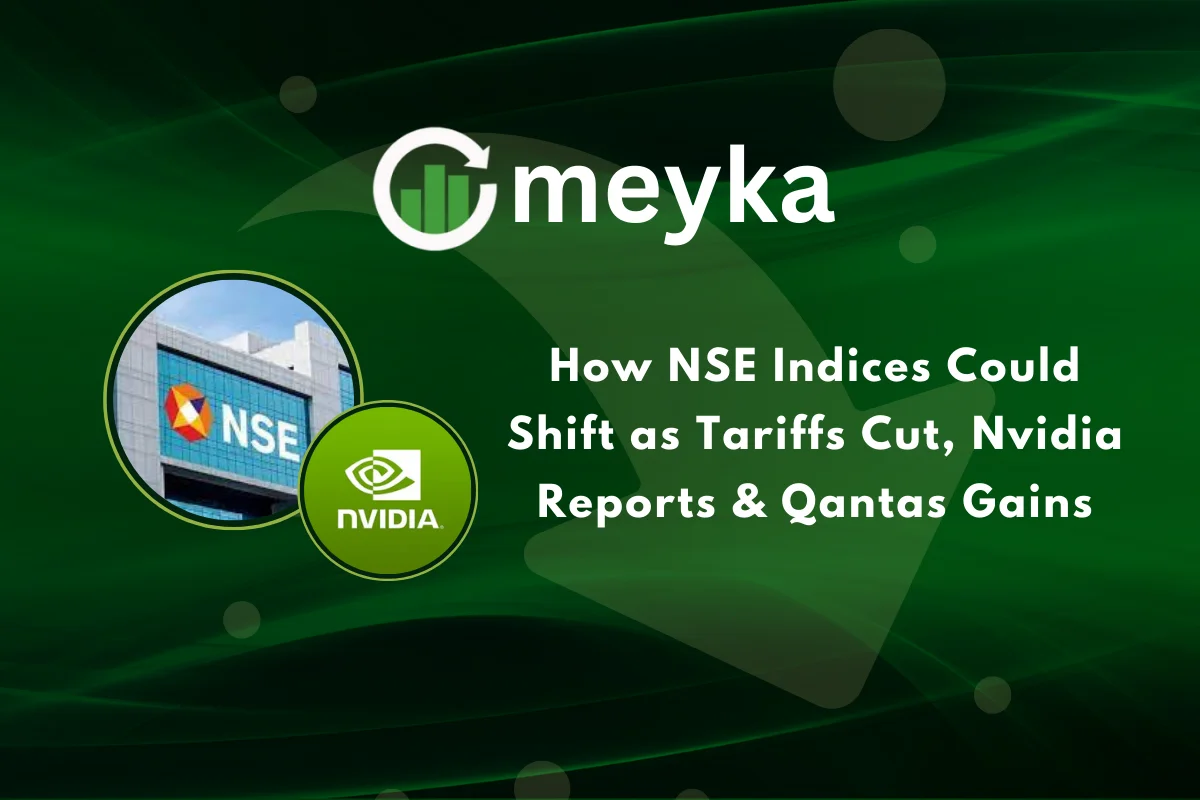How NSE Indices Could Shift as Tariffs Cut, Nvidia Reports & Qantas Gains
The NSE indices often move when big events shape global and local markets. A single policy change or a strong corporate result can change investor mood in hours. Right now, three events are drawing attention. India’s tariff cuts are expected to boost trade and reduce costs for many industries. Nvidia’s earnings report in the U.S. is also in focus, as it sets the tone for global technology stocks. At the same time, Qantas shows a strong recovery in global travel and aviation.
We see how these different factors connect. A cut in tariffs can help Indian companies grow faster. A strong Nvidia report can lift the sentiment of IT and tech-linked stocks in India. The recovery in Qantas shares can spark confidence in aviation and tourism here as well. Together, these shifts show us how global and domestic forces move NSE indices in real time.
Tariff Cuts: Immediate Shock and Sectoral Pain
The new U.S. tariffs on Indian goods are a big shock. A 50% tariff was announced and took effect in late August 2025. This move targets many Indian exports. Firms that export textiles, chemicals, and some engineering goods face higher costs and lower demand abroad. Markets hate sudden trade barriers. Stocks in export-heavy firms can fall fast. Investors watch exporters, banks that lend to them, and global supply chains tied to these firms. Policymakers in India are already looking at relief steps and negotiations to limit damage.
Tariff cuts by any country can also cut into production and pricing strategies. If tariffs are cut at the domestic level, some firms gain from lower input costs. But the headline this week is the opposite: higher U.S. barriers for Indian sellers. That creates immediate pressure on indices that include export and manufacturing names. Analysts point out that such tariffs can shave earnings estimates and force a quick re-rating of affected stocks.
How Tariffs Could Shift NSE Sector Indices?
Different sector indices will react unevenly. Export-linked indexes like Nifty IT or niche metal and chemical sub-indexes can slide on news. Banks could weaken if loan quality worries rise. Domestic consumption names may be less touched. However, market sentiment can turn broad if fear spreads. Traders may sell large-cap exporters first, then move to other sectors. That pattern can make headline NSE indices fall even when only a few sectors are hit. Live market data and commentaries in India show heightened volatility after trade shocks.
Longer term, the tariff shock may push some firms to re-route exports or localize supply. That could benefit Indian manufacturers if policy shifts toward import substitution. The timing and scale of any recovery depend on diplomatic fixes and trade talks. Until then, expect higher short-term volatility in export-sensitive NSE indices.
Nvidia Earnings: A Global Tech Signal
Nvidia’s latest quarter drew wide attention. Revenue rose year-on-year, but data-center sales were slightly below some forecasts. Export controls and China-related limits were a clear factor in the results. Global tech markets watched closely because Nvidia is a major supplier of AI chips. Moves in Nvidia’s stock often ripple through global tech ETFs and the Nasdaq. Such moves can cross oceans and hit NSE IT and tech-linked stocks.
If Nvidia beats forecasts and raises guidance, tech risk appetite lifts. Indian IT services and product firms can benefit in two ways. First, a higher global tech mood helps risk assets across markets. Second, stronger AI demand can support Indian firms that build software and services around those chips.
On the other hand, any sign of slowing in Nvidia sales due to geopolitical limits can slow global AI spending and pressure stocks tied to cloud and AI projects. That would hit the NSE IT index and related midcaps. Market commentary during the earnings window already links Nvidia news to moves in Asian and Indian tech stocks.
Qantas Gains: What an Airline Rally Means for India?
Qantas posted strong profits and firm forward guidance. The airline reported rising revenue, resumed dividends, and large aircraft orders. Investors rewarded the stock with a big jump. This reflects rising travel demand, better fuel trends, and cost fixes. Airlines around the world are now seen as recovering and returning cash to shareholders.
For India, the Qantas rally is a sentiment signal more than a direct link. Higher confidence in global travel can lift travel and tourism stocks here. Carriers like InterGlobe Aviation (IndiGo) and airport operators may see renewed investor interest. Hotels and tourism-linked stocks could also benefit. If global air travel growth continues, Indian travel demand and international connectivity will likely improve. That can give a small boost to consumer-facing indices and cyclical names on the NSE.
How the Three Stories Combine in Indian Markets?
The three events mix into a single market story. Tariff pressure raises fears for exporters and dampens some sectors. Nvidia’s results shape how investors view tech risk and AI spending. Qantas’ strength brings positive momentum for travel and cyclical demand. The net effect on NSE headline indices depends on which force is strongest at any moment.
If tariff fears dominate, markets could see broad risk-off moves. If Nvidia’s outlook is upbeat, tech-related buying could offset some export pain. Cyclical sectors may rally and push indices up if airline and travel optimism grows. Traders will react to headlines fast. Fund flows, foreign institutional moves, and currency swings will amplify moves on the NSE.
Sector Winners and Losers
Clear winners could include domestic manufacturers that rely more on local demand than exports. Discretionary names tied to travel and hospitality might also pick up gains. Tech services and cloud-adjacent firms may get a boost if Nvidia signals healthy AI spending. Losers include high-export firms in textiles, some chemicals, and engineering goods hit by U.S. tariffs. Also, any company with big China exposure could face added risk from geopolitical limits. Analysts suggest rotating toward quality names and sectors with stable domestic demand until the trade story clears.
Investor View: Practical Moves
Short-term traders should watch earnings windows, tariff-related headlines, and global tech guidance. Longer-term investors may look for buying chances in beaten-down export names once clarity returns. Diversified funds and sector ETFs can reduce single-stock risk. Currency hedges may help if rupee swings increase after trade news. Keep an eye on central bank comments, as policy responses can shape the recovery path for markets.
Final Thought
Markets now respond faster to global news. Trade policy, big tech earnings, and sector recoveries can sway the NSE in short order. Focus on the facts, track company earnings, and watch how diplomats react to trade moves. That should help make smarter decisions while markets adjust to these new realities.
Frequently Asked Questions (FAQs)
NSE indices are benchmarks created by the National Stock Exchange of India. They track groups of companies, show market trends, and help investors measure performance.
The Indian stock market has over 350 indices managed by NSE. These include broad market indices, thematic indices, strategy indices, fixed income indices, and sectoral indices.
The most popular NSE index, Nifty 50, includes 50 large companies across many sectors. These companies represent about 65% of the total market capitalization.
NSE has 15 sectoral indices. They cover industries like banking, auto, IT, pharma, FMCG, energy, metals, and more. Each reflects the performance of its respective industry.
Disclaimer:
This is for informational purposes only and does not constitute financial advice. Always do your research.






